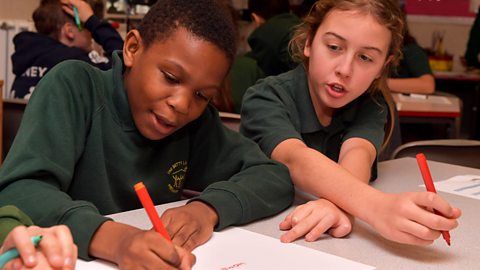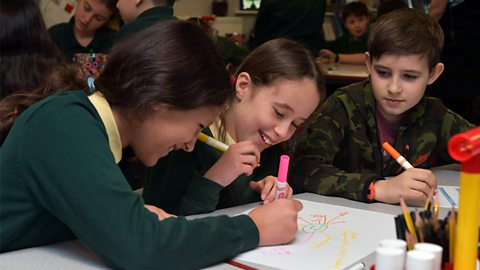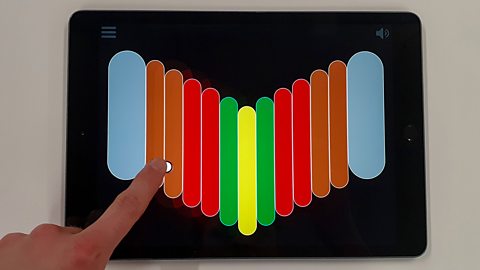A handy guide for newcomers to Ten Pieces
Welcome to BBC Ten Pieces! You have arrived at the BBC’s largest educational resource for classical music.
BBC Ten Pieces is a fantastic resource for anyone delivering music education in any context. There are exciting films, lesson plans, instrumental arrangements, inclusive resources and more.
Below are some suggested steps for getting started…
Step 1) Choose a piece of classical music
Choose a piece of music in the BBC Ten Pieces collection - there are 50 pieces to choose from!
Why not pick one of the newest Ten Pieces? To mark the tenth anniversary of BBC Ten Pieces in 2024, a fantastic collection of works by women composers was added.
Naomi Wilkinson explores the busy, hopeful soundscape of spring created by the rhythms and dynamics of Lili Boulanger's D'un matin de printemps
Naomi:
What do you notice when the seasons change? Different colours? A change in the weather?
What about the sounds that you can hear?
The leaves in the trees sound different when they're fresh in the spring, rather than when they're dry and crispy in autumn, or in winter when there aren't any leaves at all.
Each season has its own soundscape, and none is busier and more hopeful than the spring.
When you're out and about in springtime you can hear bees buzzing and birds singing. It's all going on. And it was the busyness and joy of springtime that inspired French composer Marie Juliet Olga Boulanger, known to her friends -that's us- as Lili, to write her piece D’un matin de printemps. That's French for ‘On a Spring Morning’.
Lili Boulanger is using the instruments to create the sounds and feeling of a busy spring morning out in the garden or in the park. The string instruments are playing a fast repeated rhythm, over and over. It's called an ostinato. Almost feels like the hum or buzz of bees, busy and constant.
The melody played by the flute at the beginning is copied by different instruments as it echoes through the orchestra.
It's a bit like birds singing or calling to one another.
Lili Boulanger was born in Paris in 1893, and even from a really young age, she loved playing music, and she was a very talented composer.
D’un matin de printemps - On a Spring Morning - was written as part of a pair of pieces. The other half of the pair was D’un soir triste, which means On a Sad Evening. That's quite a different vibe from a spring morning, isn't it?
I wonder why Lili wrote these two pieces to go together. This young woman was feeling inspired by the hope of spring, so she was feeling hopeful. But she was also very ill, and sadly, she died when she was just 24 years old. By writing both pieces, Lili Boulanger is showing the world that she was feeling several emotions all at once.
Oh, now what kind of bird is that? I have a trusty book of bird facts here to help me. It’s like a handy set of instructions for nature. And luckily many composers give instructions too, on how their pieces should be played. It means the musicians are able to play the piece as the composer intended.
At the beginning of On a Spring Morning, Lili Boulanger asks that the notes be played, in French, léger and gai, which means light and cheerful. After a happy and energetic start to the music, the mood changes. Here, the instruction from the composer is to play mystérieux, or mysteriously, with slower, longer notes.
I wonder what could be happening out in the garden during this change?
The clouds are rolling in. The music builds and builds and listen, here comes the rain.
But don't give up and head inside just yet. No, a violin solo plays the spring melody from the beginning of the piece.
The rain is stopping. Sun is peeking through the clouds. Typical spring weather!
Step 2) Watch the Ten Pieces films
Once you've selected your music, discover the two films for each piece: the introductory film and the performance film
The introductory film explains the story or history behind the music and the composer, led by a presenter and sometimes featuring the composer, like Errollyn Wallen's Mighty River, or Laura Shigihara's Grasswalk.
The performance films feature the BBC Orchestras, BBC Singers and other choirs, e.g. Lili Boulanger's D'un matin de printemps, or Judith Weir's Magic, there are even performances exclusively by young people, like this piece by Kerry Andrew, No Place Like and Anna Meredith's Connect It
Browse all introduction and performance films
Take a look at the collection of films introducing the individual pieces alongside the performances.


Step 3) Explore and get creative with the piece you have chosen
All 50 pieces of classical music have schemes of either 4 or 6 lesson plans that can be used and adapted to suit your setting and the needs of your cohort.
Links to lesson plans can be found at the bottom of each composer page.


Step 4) Looking for direct links to the music curriculum (for England, Scotland, Wales and Northern Ireland)?
You can find Ten Pieces that are helpful for for exploring the various elements of music e.g. duration, metre, rhythm, dynamics, pitch, structure, tempo, texture, timbre. These elements of music are known as the interrelated dimensions of music in the National Curriculum in England, and also cover the necessary elements of music for the Curriculum for Wales: Expressive Arts, Scotland Curriculum for Excellence and Northern Ireland Primary Curriculum.
Many of the BBC Ten Pieces and their composers are recommended in the Model Music Curriculum (England). If you're using the MMC and want inspiration, use this handy index to take you straight to a MMC piece or a composer.

Step 5) Explore the inclusive resources
There are many resources for children with Special Education Needs and Disabilities, including arrangements for adaptive instruments.
- Arrangements with notation options including traditional, Arrownotes, and Figurenotes notation
- Arrangements with instrument options including Clarion, ThumbJam, Soundbeam, CMPSR and other adaptive or traditional instruments using any of the above notation systems
Inclusive Resources
A photo of a finger pressing buttons on the Clarion app on an iPad.

Step 6) Showcase your creative responses to the music
Most of the lesson plans involve composing a creative response inspired by your chosen piece. Why not make it into a performance?
You might rehearse your class with the goal of performing your piece to an audience, or split your class intro groups and perform creative responses to each other. This is a great opportunity for sharing the work the class has done and gives a sense of achievement!
You can upload your creative responses to the Ten Pieces website for your chance to feature in the BBC Ten Pieces Creative Response Showcase.
You might even want to share your work with the Ten Pieces team on socials by using #BBCTenPieces in your post.
If you are an educator who works with ensembles, why not explore the range of Ten Pieces orchestral and vocal arrangements. These are simplified instrumental arrangements for various abilities from Beginner to Grade 5 and beyond.
Step 7) Reach out to a local Ten Pieces Champion
Champions are Music Education Hubs, Music Services, orchestras, film, dance and other arts organisations from across the UK working in collaboration with the BBC to introduce classical music to the next generation.
If you feel you want some extra support with using Ten Pieces or want to explore further opportunities for music education in your area, finding your nearest Champion could be a good next step. You can find out more about Champions here.
Good luck with your Ten Pieces journey! #BBCTenPieces
Ten Pieces Champions
Ten Pieces Champions are Music Education Hubs, Music Services, orchestras, film, dance and other arts organisations from across the UK working in collaboration with the BBC to introduce classical music to the next generation.

